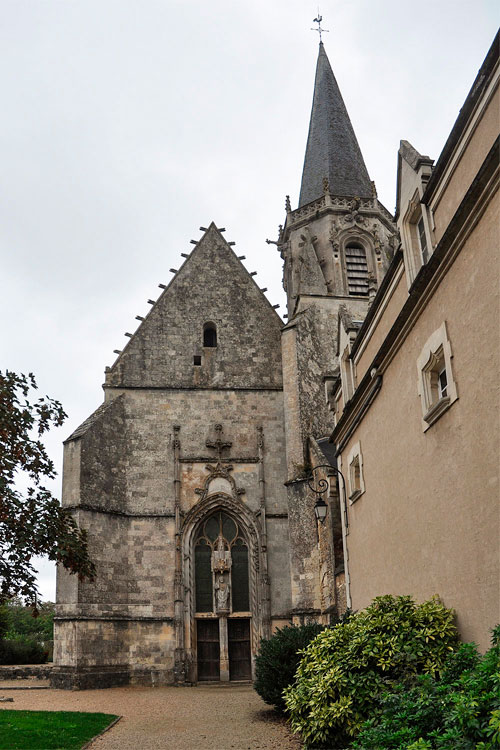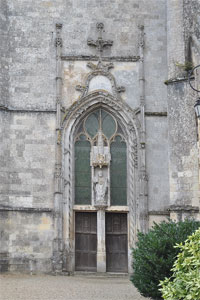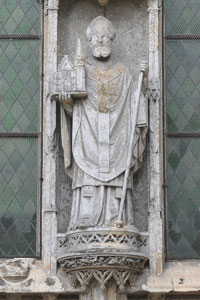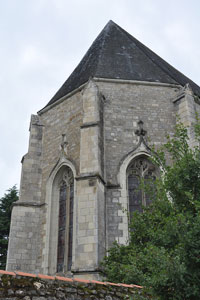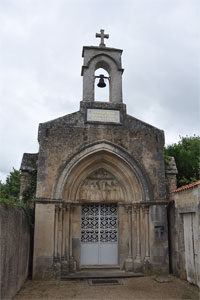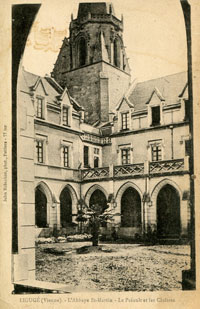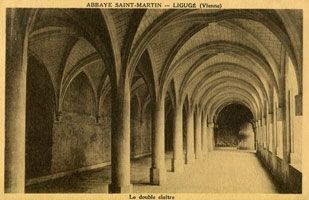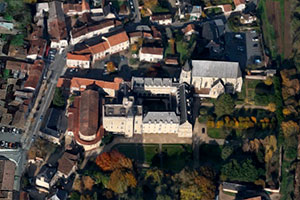The foundation of the monastery of Saint-Martin de Ligugé is attributed to Martin of Tours (c. 316–397), regarded as one of the pioneers of early monasticism in Gaul. Martin was trained in Poitiers, where he arrived in 356 and became a disciple of Bishop Hilary (c. 315–367). After a period away from the city, in 361 he retired to a site in the surrounding area, granted to him by Hilary, which corresponds to present-day Ligugé—a location with archaeological remains indicating Gallo-Roman occupation.
Around him gathered disciples who gave rise to a coenobitic community, as the fame of his sanctity spread. One of the saint’s best-known miracles is said to have taken place here: the resurrection of a catechumen who had died during Martin’s absence. Upon returning, Martin prayed over him and restored him to life so that he could be baptised. His popularity became so great that in 371 he was proclaimed bishop of Tours, despite his initial reluctance—a position he combined with the practice of monastic life at Marmoutier (Indre-et-Loire), where he also founded a monastery.
Although little information survives, it is likely that the community at Ligugé continued to exist. Its presence is only securely attested in the year 591, when it was visited by Gregory of Tours (c. 538–594). Surviving sources mention various destructions and reconstructions. The monk Defensor of Ligugé composed the Liber scintillarum around 700. Archaeological remains next the present church are thought to date from that time. In the 8th century, the monastery fell victim to Viking raids and political instability, and it was eventually abandoned, disappearing from the record for nearly two centuries.
A funerary slab for an unknown abbot, dated to the 8th or 9th century, records that he built a basilica dedicated to Saint Martin. Both church and monastery are thought to have been destroyed around the mid-9th century during a Norman attack. Around 1003, Countess Adalmodis († c. 1005), wife of William III of Poitiers (William V of Aquitaine, c. 969–1030), founded a sanctuary dedicated to Saint Martin on the same site. She entrusted it to monks from the abbey of Maillezais (Vendée), recently established. In the first half of the 12th century, the site became a priory dependent on that monastery. However, the first known reference to Ligugé as a priory of Maillezais comes in a bull of Pope Celestine III, dated 1197.
Despite being a priory under the jurisdiction of another abbey, Ligugé became a wealthy and influential establishment thanks to the prestige of its founder. In 1268, Prince Alphonse of Poitiers granted it the privilege of administering justice. Pope Clement V later took up temporary residence at Ligugé, taking advantage of its proximity to Poitiers during the dissolution of the Order of the Temple. The priory suffered attacks in 1346 and 1359, during the Hundred Years’ War, and was almost entirely destroyed. These events, along with the decline of Maillezais following its elevation to a bishopric in 1317, ushered in a period of stagnation for Ligugé throughout the 15th century.
From 1501, the monastery came under the control of commendatory priors, chosen from among the canons of Maillezais, who promoted the rebuilding of the monastic buildings. A new church was constructed to the east of the original one, with an enlarged chancel. In 1569, the priory again suffered destruction, this time during the Wars of Religion, when the buildings burned for three days. In 1607, with the consent of the bishop of Maillezais, the priory of Ligugé was entrusted to the Jesuits of Poitiers. They undertook restorations and used the site as a retreat house until their expulsion in 1762.
Following the Jesuits’ departure, the property passed to the cathedral chapter of Poitiers, which retained it until the French Revolution. In 1793 the estate was confiscated by the State and sold. The monastic tradition, interrupted with the arrival of the Jesuits, was restored in 1853 with the arrival of a new Benedictine community from the abbey of Solesmes (Sarthe). In 1856, the priory was elevated to the status of an abbey, and new foundations were launched from Ligugé. In 1880, the monks were once again expelled and found refuge at the monastery of Santo Domingo de Silos (Burgos), where they restored the ancient Benedictine abbey, which remains active today.
In 1885, the community returned to Ligugé, although they were forced into exile again between 1901 and 1923. Most of the present-day monastic complex dates from the 19th century. In addition to early archaeological vestiges, the oldest building is the parish church of Saint-Martin, which was originally the monastic church rebuilt in the 16th century after the Wars of Religion, and later modified. The current monastic church of the community, located to the west, was built in the 20th century.
- BEAUNIER, Dom (1910). Abbayes et prieurés de l'ancienne France. Vol. 3: Auch, Bordeaux. Abbaye de Ligugé
- BORD, Lucien-Jean (2005). Histoire de l'abbaye Saint-Martin de Ligugé. 361-2001. Paris: Geuthner
- CHAMARD, François (1873). Saint-Martin et son monastère de Ligugé. Poitiers: Oudin
- COLOMBÁS, García M. (2004). El monacato primitivo. Madrid: Biblioteca de Autores Cristianos
- COQUET, Jean (1955). Les édifices religieux du Haut Moyen Age à l’Abbaye de Ligugé. Revue Mabillon, XLV. Abbaye Saint-Martin de Ligugé
- COTTINEAU, Laurent-Henri (1936). Répertoire topo-bibliographique des abbayes et prieurés. Vol. 1. Mâcon: Protat
- COUSSEAU, A. (4840). Mémoire sur le plus ancien monastère des Gaules, er sur l’état actuel de l'église de Ligugé. Mémoires de la Société des antiquaires de l'Ouest
